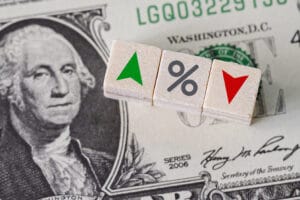Observers say mortgage interest rates will likely rise in the latter half of next year following the Federal Reserve’s announcement that it would begin to taper a massive bond-buying program it started to prop up the economy in the early stages of the COVID-19 pandemic last year.
The Fed will keep interest rates near zero for now, its policy-making Federal Open Markets Committee (FOMC) said in a statement Wednesday. But it will reduce the volume of U.S. Treasury bonds it buys each month by $10 billion and the volume of agency mortgage-backed securities it buys each month by $5 billion. By reducing its bond-buying by the same amount each month, the Fed will have completely tapered off its asset purchases by June of next year, although the central bank said the pace could be changed depending on the economic outlook.
“As was broadly expected, the FOMC announced that it would begin tapering asset purchases,” NAFCU Chief Economist Curt Long said in a statement. “The $15 billion per month pace of tapering was also in line with expectations and puts the Federal Reserve on track to wind down the process by June 2022. If inflationary pressures persist beyond the next month or two, a June date for a rate increase is likely. However, NAFCU continues to believe that liftoff is more likely to occur later next in 2022.”
Raising rates in June would be much earlier than was expected as recently as this summer, when Fed policymakers forecast that they wouldn’t do so until late 2023. But with housing costs and prices of other daily necessities rising rapidly thanks, in part, to some of the cheapest interest rates seen in living memory, pressure has been building on the fed to act. The moves announced Wednesday could send mortgage interest rates to start creping up next year, but still stay low, one expert said.
“The pace of home-price growth and rental growth will likely be reflected in faster growth of the shelter components in several inflation measures. This trend is one reason why we believe that higher inflation is likely to persist. Shelter prices continue to face upward pressures because of the lack of for-sale inventory and decreasing vacancy rates for apartments,” Mortgage Bankers Association Chief Economist Mike Fratantoni said in a statement following the Fed’s announcement. “As the Fed’s actions were anticipated, this announcement will not impact our latest forecast for mortgage rates and mortgage originations. We expect that rates on 30-year mortgages will increase from 3.2 [percent] today to about 4 [percent] by the end of 2022.”
Once the Fed has ended its bond purchases by mid-2022, it will then turn to a more difficult decision: When to raise its benchmark short-term rate from zero, where it’s been since COVID-19 hammered the economy in March 2020. Raising that rate, which affects many consumer and business loans, would be intended to make sure inflation doesn’t get out of control. But it would carry the risk of discouraging spending and undercutting the job market and the economy before they’ve regained full health.
“We don’t have a roadmap for what we’re going through,” said Diane Swonk, chief economist at Grant Thornton. Powell has to “walk a tightrope” by supporting the recovery while not “turning a deaf ear to inflation.”
Yet the risk is that the Fed might end up raising rates too soon. Supply bottlenecks may loosen in the coming months. If the Fed were to raise rates at the same time, it could depress spending and weaken the economy just as its supply problems are healing.
Eric Winograd, an economist at asset manager Alliance Bernstein, said Powell’s comments seemed to suggest that he sees problematic inflation as “hypothetical rather than a realized event.”
“The Fed clearly does not think that inflation is likely to stay at or near current levels, nor does it think that the labor market is back to full employment,” Winograd added. “Until they become convinced either that inflation is durably too high, that inflation expectations have become unanchored or that the economy is at full employment, they do not intend to raise interest rates.”
Powell did say that high prices could last into late next summer. But he stuck by the Fed’s view that they’ll likely decline after that. He also said that the large wage increases many Americans have received in recent months aren’t fueling inflation further. Wages and salaries soared in the July-September period from a year earlier by the most in at least 20 years.
Associated Press writer Christopher Rugaber contributed to this report.







